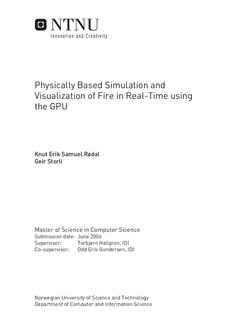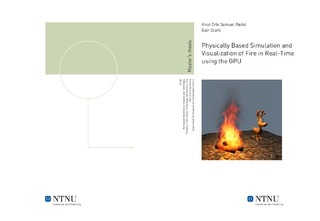| dc.description.abstract | Fire is a powerful natural effect which can greatly enhance the immersion of virtual environments and games. In this thesis we describe the theory and GPU implementation of a physically based approach for simulating and visualizing 3D fire in real-time. Previous approaches are generally lacking either in visual quality, turbulence and flickering, or flexibility and extensibility. We attempt to address all these issues by using an underlying fluid simulation, modeling the mass and heat transfer aspects of the physics of fire, in combination with an explicit combustion process. The fluid simulation is used to control the behavior of a velocity field governing the motion of fuel gas, hot exhaust gas, and temperature fields, and the combustion process models the conversion of fuel gas to exhaust gas when the temperature is above the ignition temperature of the fuel gas. The velocity field is among other affected by vorticity confinement, causing a more turbulent and flickering fire, and a buoyancy force modeling upward motion. We perform the fire simulation both in 3D and in a set of 2D slices using volumetric extrusion to define an implicit 3D domain. In order to achieve satisfying visual quality, we visualize the fire using a particle system of textured particles guided by the results from the fire simulation. The particle colors are based on black-body radiation from the hot exhaust gas, and the particles move according to the velocity field from the fluid simulation. A similar particle system is used to visualize the cooled exhaust gas or smoke. As an alternative to particle systems we have also implemented a volume rendering approach for visualizing fire, but it falls short both in performance and visual quality. Finally, we model dynamic illumination, approximating the illumination from the fire on the surrounding scene by a set of point lights, whose intensities are computed in a similar fashion as the fire particle colors. The point lights are either stationary positioned near the center of the fire, or set to follow the velocity field just like the particles of the fire and smoke particle systems. Both the simulation and visualization of fire are implemented completely on the GPU, ensuring high frame rates without sacrificing visual quality. We have achieved a flickering and turbulent fire which compares favorably to previous approaches and works well in virtual environments, especially due to the dynamic illumination. The fire visualization also has realistic colors and intensity, and thus captures important elements of real fire. Our underlying physically based simulation enables us to efficiently simulate a variety of different kinds of small-scale fires, by altering a set of simulation parameters. One of our main contributions is implementing the explicit combustion process with fluid simulation on the GPU, as well as using it in combination with vorticity confinement and volumetric extrusion. Our contributions also include the dynamic illumination already mentioned, simulation domain advection, a novel method for modeling the behavior of fire as it is moved, and using time-dependent noise curves to model dynamic wind affecting the fire. | nb_NO |

